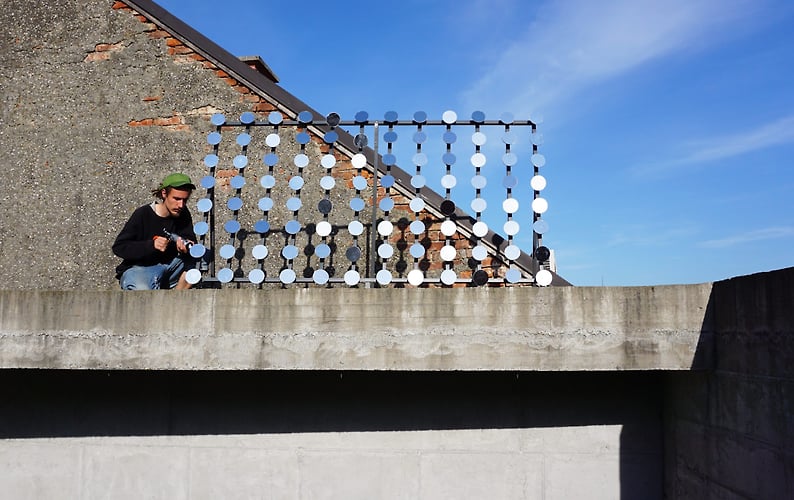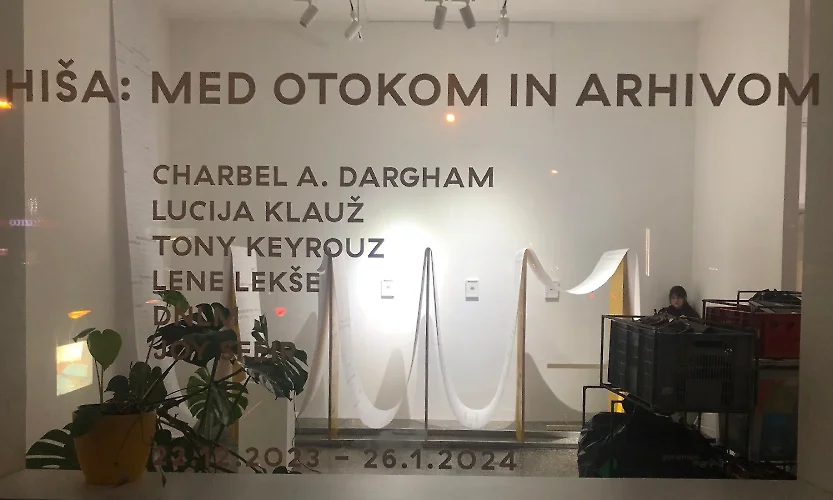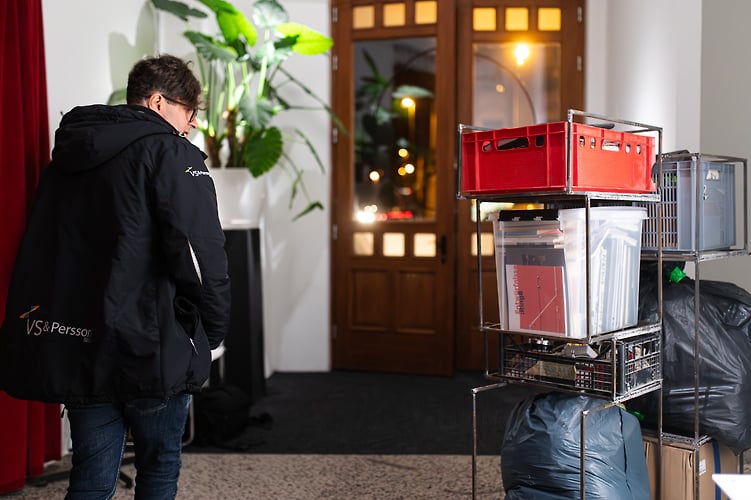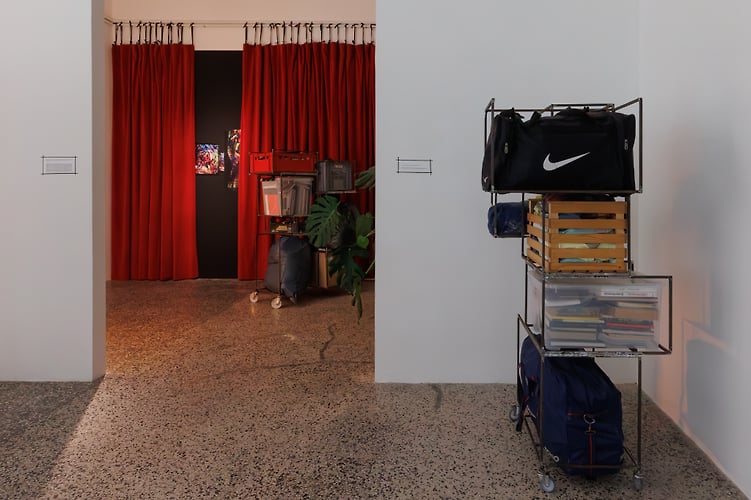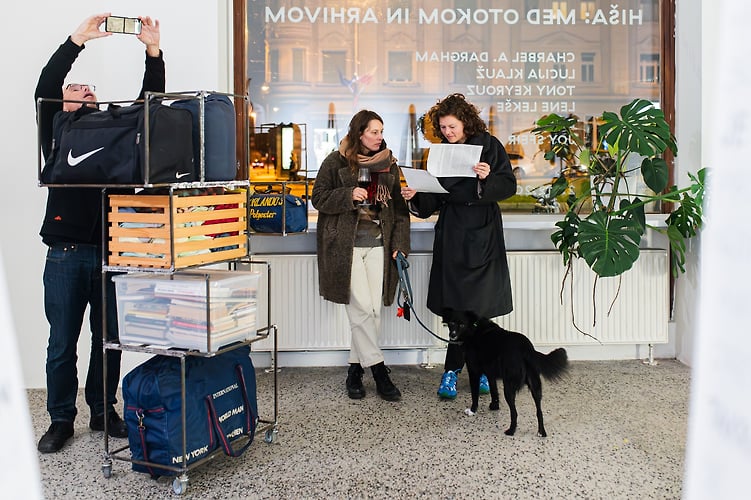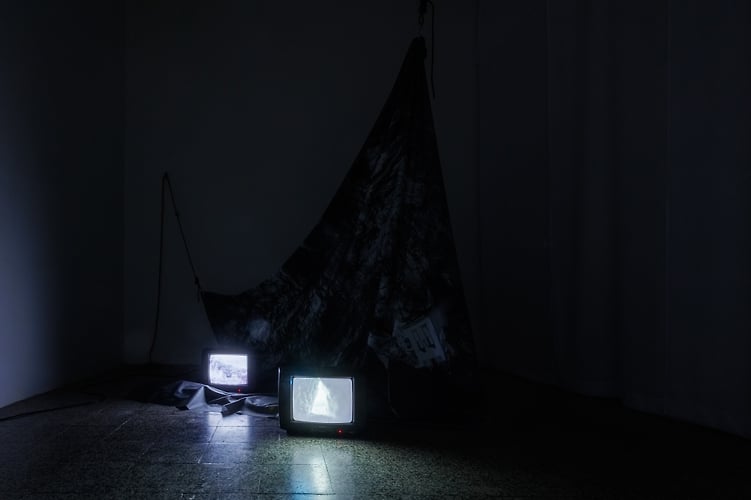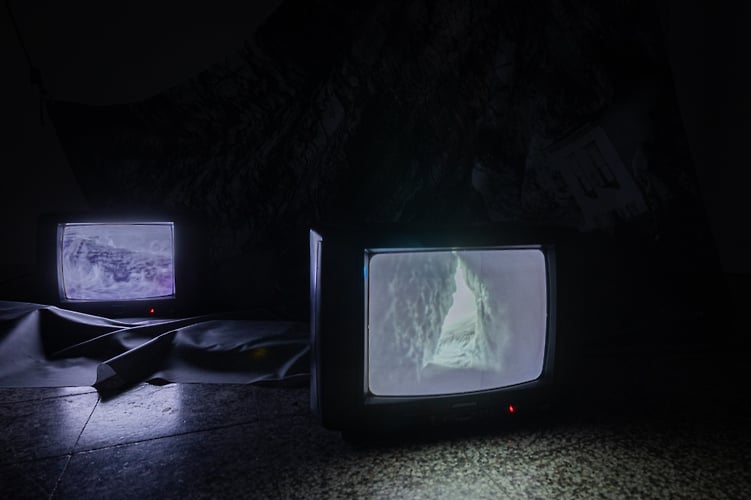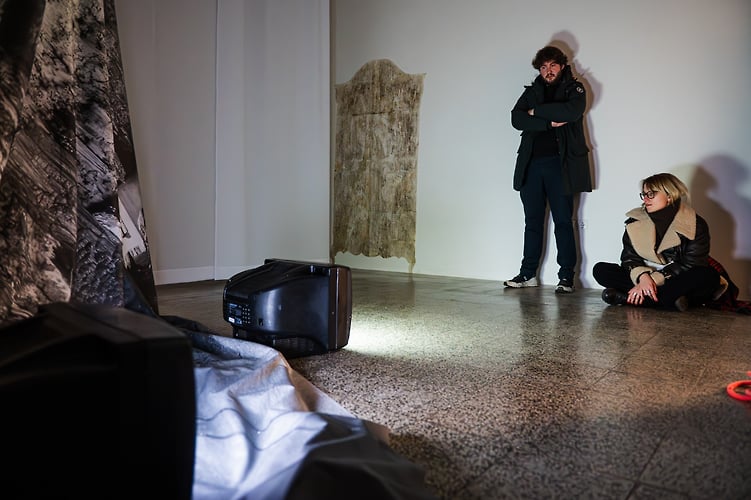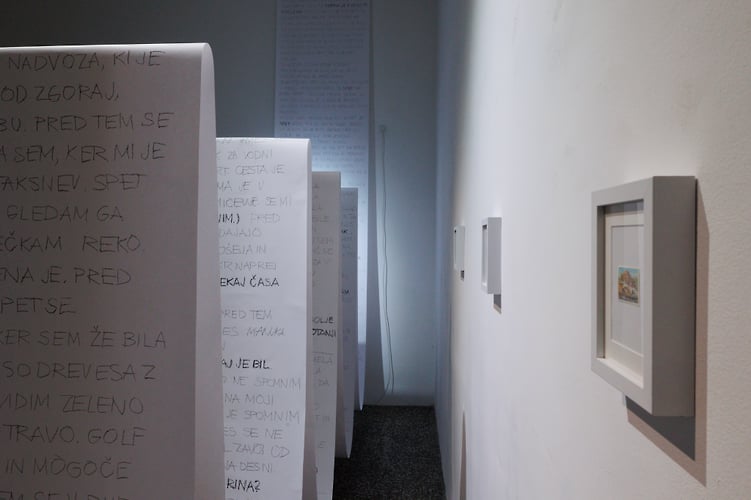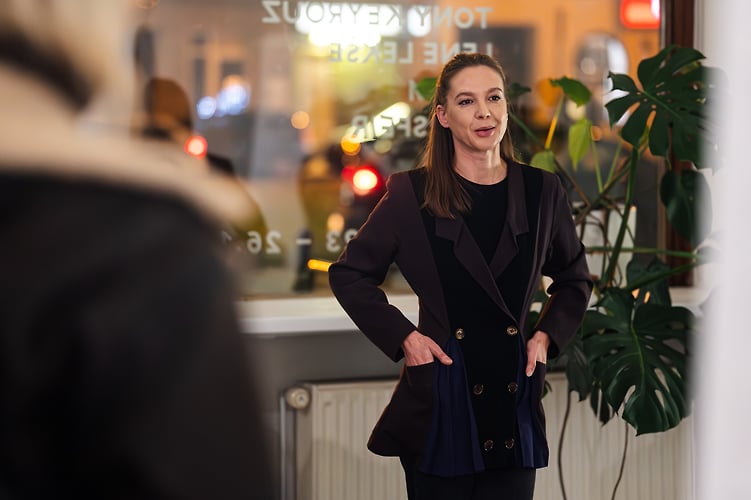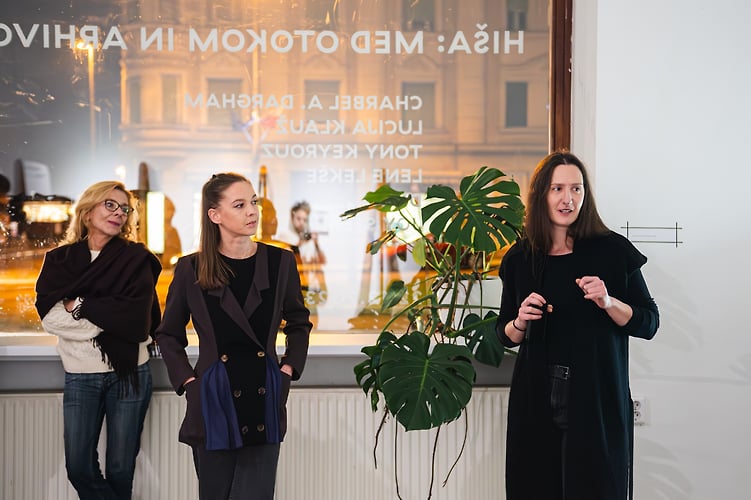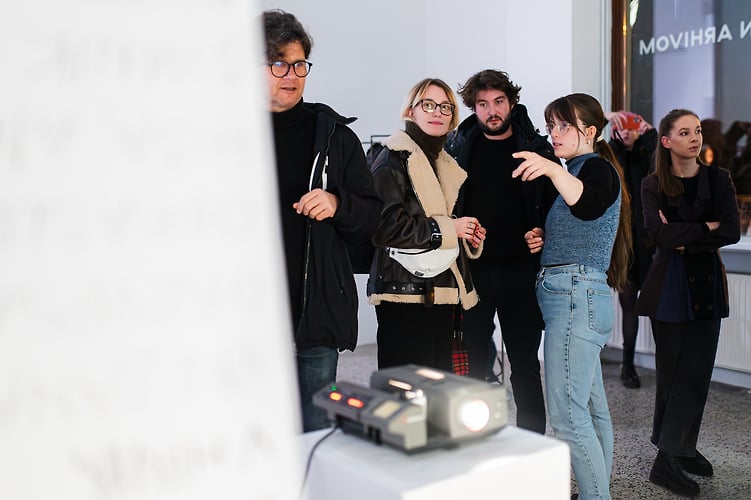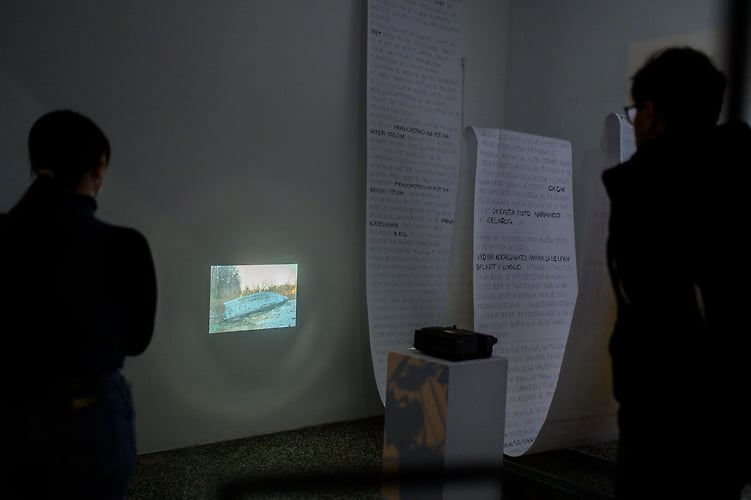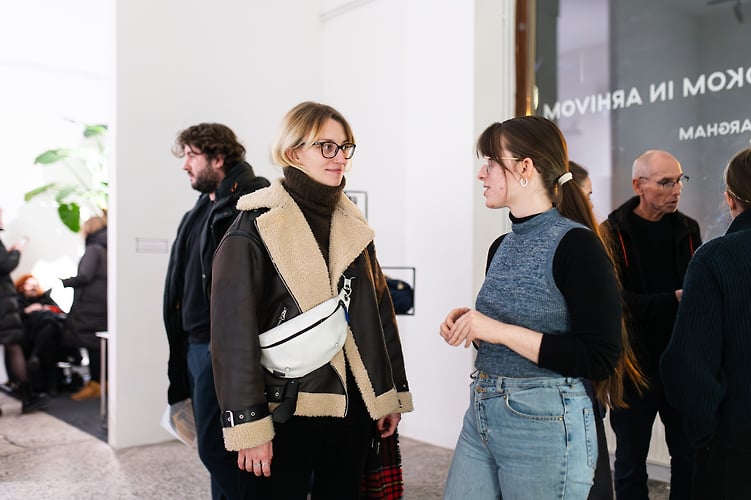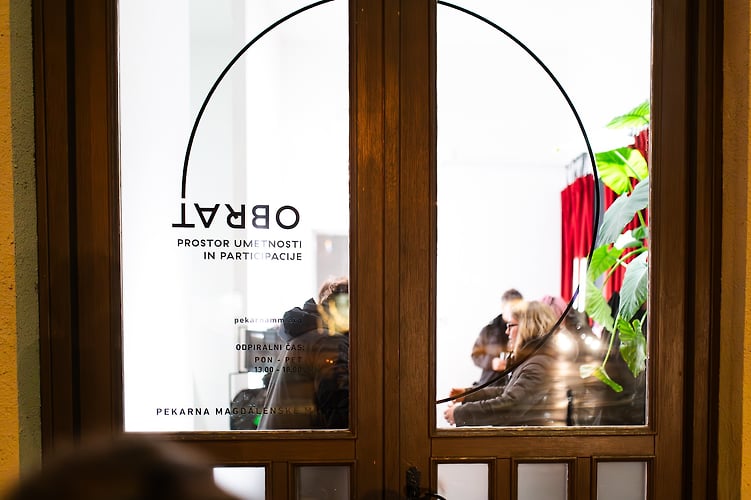LUCIJA KLAUŽ, LENE LEKŠE, DANILO MILOVANOVIĆ (ENG)
GuestRoomMaribor October - December 2023
The House: Between an Island and an Archive, 2. part
LENE LEKŠE // LUCIJA KLAUŽ // DNLM
(Slovenia)
LENE LEKŠE graduated from the ALUO UL in 2018, majoring in sculpture. During her studies she spent one year on exchange in the Netherlands, at the Minerva Academy in Groningen. She has received two awards from the Academy of Fine Arts and is a scholarship holder at the MOL. Since 2014, she has been running animation workshops for children within the SLON association. Since 2018, together with Lara Reichmann, Mihael Novak, Nina Goropečnik and Maša Knapič, she has been organising student exhibitions around Slovenia as part of the Gallery 7:069 project.
http://www.lenelekse.com
LUCIJA KLAUŽ is currently finishing her studies at the ALUO UL in the field of video and new media. She also participated in the Young Masters exchange programme in Tunisia as part of the Interfeerence Light Festival. She works as a journalist at Radio Student, where she covers art and literature. She also works with Film Factory, an organisation focusing on film literacy and education for young people and their educators.
DNLM (Danilo Milovanović) completed his postgraduate studies in painting at the ALUO UL. He also studied at the Academy UMPRUM in Prague. In 2020, he received the Prešeren Prize of the Academy of Ljubljana for his master's thesis Artivism - Engaged Urban Art in the Public Space / Top Parking Project. In 2018 and 2019 he was nominated for the OHO Prize, and he has participated in several artist residencies in Europe and beyond.
http://www.e-arhiv.org/diva/DaniloMilovanovic
http://www.lenelekse.com
LUCIJA KLAUŽ is currently finishing her studies at the ALUO UL in the field of video and new media. She also participated in the Young Masters exchange programme in Tunisia as part of the Interfeerence Light Festival. She works as a journalist at Radio Student, where she covers art and literature. She also works with Film Factory, an organisation focusing on film literacy and education for young people and their educators.
DNLM (Danilo Milovanović) completed his postgraduate studies in painting at the ALUO UL. He also studied at the Academy UMPRUM in Prague. In 2020, he received the Prešeren Prize of the Academy of Ljubljana for his master's thesis Artivism - Engaged Urban Art in the Public Space / Top Parking Project. In 2018 and 2019 he was nominated for the OHO Prize, and he has participated in several artist residencies in Europe and beyond.
http://www.e-arhiv.org/diva/DaniloMilovanovic
Final exhibition
THE HOUSE: BETWEEN THE ISLAND AND THE ARCHIVE
Charbel A. Dargham, Lene Lekše, Tony Keyrouz, Lucija Klauž, DNML, Joy Sfeir
Exhibition on view from December 22nd 2023 - January 26th 2024
@OBRAT - space for art and participation, Trg revolucije 9, Maribor
The exhibition is the second and final part of an exchange project between Lebanese and Slovenian artists of the younger generation. The first part of the project was realized in the form of a residency and the exhibition Of Fractious Shifts, An Upright Room, by Lebanese artists Charbel A. Dargham, Tony Keyrouz and Joy Sfeir between August and September this year at OBRAT. According to the original idea, the project was to culminate in a final group exhibition of Lebanese and Slovenian artists at the Zico House Cultural Centre – a family villa in Beirut built in 1935 and turned into a cultural center in the 1990s. As it is a specific exhibition space, the project as a whole was conceived on the basis of an initial reflection on space, specifically intimate space in relation to public space, and above all on the experience of space. Due to the current circumstances of the siege of Palestine, we decided to carry out the final exhibition in OBRAT, with the works presented – as in the original idea – stemming from a reflection on the poetics and experience of space.
Works by Lebanese artists that have already been exhibited at OBRAT are transformed into miniatures and archival documentation in this exhibition, which attempts to reconstruct not only their optical/visual, but above all their experiential/corporeal aspects. Such a strategy of reconstructing the initial works stems, among other things, from a reflection on the fact that the experience of space - in addition to always being mediated by representations and symbols - is in the course of (art) history often reduced to the object of the gaze, the backdrop, the scenography or the territory, which is subjected to a visual mapping, while a holistic bodily experience of space, which includes not only vision but also touch, a sense of balance and a sense of the body, can question normative approaches to the mastery of the space through representation. In this exhibition, archival miniatures of works by Lebanese artists are placed in tentatively identical locations in the gallery as the first time, thus establishing a relationship with the new, not yet presented works by Slovenian artists Lene Lekše, Lucija Klauž and DNML (Danilo Milovanović), which were originally conceived to be created during their one-month residency in Lebanon.
-

كفضاء, Tony Keyrouz, spatial installation, August 2023
Spatial installation in the fram ef the exhibition Of fractious shifts, an upright room, August 2023 -

كفضاء, Tony Keyrouz, miniature, 2023
Miniature of the work in the fram eof the exhibition House: between an Island and an Archive, December 2023 -
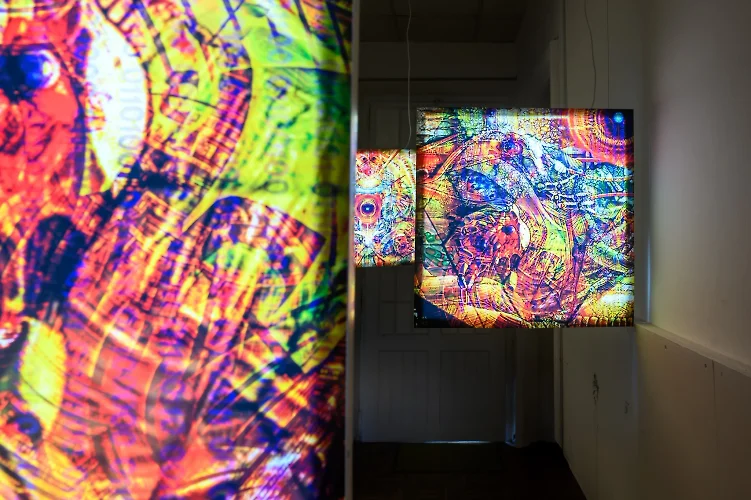
Charbel A. Dargham, A rather peculiar map, first setup, August 2023
Spatial installation at the exhibition Of Fractious Shifts, an Upright Room, August 2023 -
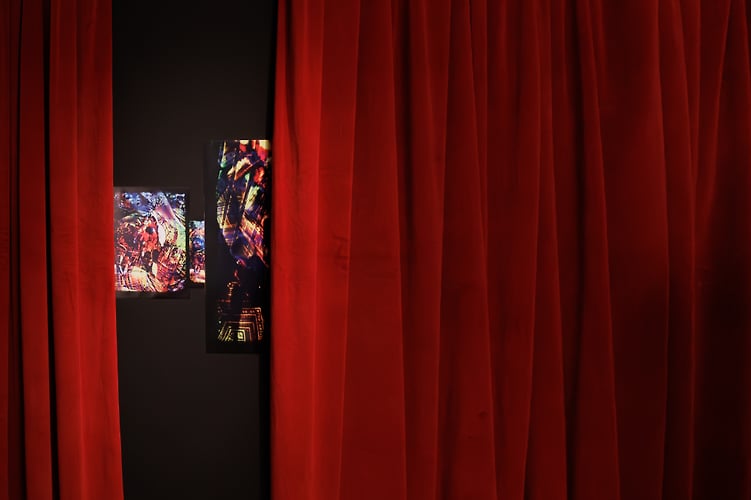
Charbel A. Dargham, A rather peculiar map, reconstruction, December 2023
Reconstruction of the work in the context of the exhibition The House: between the island and the archive, December 2023 -

Joy Sfeir, Le temoins invisibles, spatial installation, August 2023
Original installation as part of the exhibition Of Fractious Shifts, an Upright Room, August 2023 -

Joy Sfeir, Le temoins invisibles, reconstruction, December 2023
Left: Joy Sfeir, Le temoins invisibles, miniature reconstruction as part of the exhibition The House: between the island and the archive, December 2023
Right: Lene Lekše, Uncertain grounds, House: between the island and the archive, December 2023
Original installations and reconstructions of works by Lebanese artists Tony Keyrouz, Charbel A. Dargham in Joy Sfeir, August and December 2023
In the text "The Ground and Losing It: Landscape in Modern and Contemporary Slovenian Art (Four Examples)", Igor Zabel juxtaposes excerpts from Slovenian art history from the beginning of the 20th century to the end of the 20th century in order to explain the changing perception and experience of landscape and space. As a first example, he highlighted Jakopič's impressionist-expressionist reworking of landscape painting tradition, where the image of the typical cultural landscape is established as a symbolic site of cultural memory, and, therefore, closely linked to identity, the idea of soil and native land. As the second example, Zabel highlighted the land art of OHO, in short, direct artistic interventions in the natural landscape since the end of the 1960s, followed by the palimpsestic (especially Istrian) landscape of the painter Emerik Bernard, which "lost" the ground and turned into a mass of material traces on the pictorial medium. Based on the work of Marjetica Potrč during the 1990s, Zabel pointed to a radical shift from landscape as a symbol towards concrete (especially urban) space and its cartography, in parallel with the fact that urban space - due to socio-political changes - was also undergoing radical transformations.
The main body of DNML's work could to some extent be placed in continuity with the new way space has begun to appear in contemporary art since the 1990s, where the visualization of its changes are at the forefront. The guerrilla interventions in public space, which from this very period were established as one of the key contemporary-art strategies for thematising space, in DNML's work nevertheless point to certain traces of the intrusion of the digital logic into the perception and experience of physical space, as his working method is often based on a ‘cut-copy-paste’ strategy of decontextualising and re-contextualising snippets of concrete urban space, through which he reveals processes in the urban space that are indicators of capital interests, political governance and control, as well as social relations and inequalities. The work Stray Baggage, DNML made for the present exhibition, is nonetheless specific, as he focuses more on the specificities of intimate space as defined by the current circumstances of precarisation, almost forced mobility, nomadism and temporarity, and consequently also the experience of no- or multi-domesticity, rather than on public space.
DNML's work starts from a basic consideration of what should define domestic/intimate space, pursuing the thesis that it is primarily a by-product of the presence of the one who inhabits it temporarily or permanently - most often through the objects he leaves in the space and through which he domesticates and adapts its architectural and geophysical givens. The intimate space defined in this way therefore inevitably has the character of an archive, of which we are often fully aware, especially when we relocate, which, with its frequency, also forces us to economize our presence in space qua objects - to confine it, for example, to various smaller cubicles and to disperse it in several basement, attic or sub-basement spaces of our neighbors. The work Stray Luggage is conceived as a reunited collection of these scattered traces of DNML's past presence from past homes, which he has installed in two movable packing racks. It can be read either as a condensed archive of the artist's intimate spaces, a ready-made assemblage with certain formal-aesthetic qualities, or simply as a temporary (i.e. for the duration of the exhibition) solution to a problem faced by certain populations and/or generations who have no possibility of a permanent solution to their housing problem.
In the text "The Ground and Losing It: Landscape in Modern and Contemporary Slovenian Art (Four Examples)", Igor Zabel juxtaposes excerpts from Slovenian art history from the beginning of the 20th century to the end of the 20th century in order to explain the changing perception and experience of landscape and space. As a first example, he highlighted Jakopič's impressionist-expressionist reworking of landscape painting tradition, where the image of the typical cultural landscape is established as a symbolic site of cultural memory, and, therefore, closely linked to identity, the idea of soil and native land. As the second example, Zabel highlighted the land art of OHO, in short, direct artistic interventions in the natural landscape since the end of the 1960s, followed by the palimpsestic (especially Istrian) landscape of the painter Emerik Bernard, which "lost" the ground and turned into a mass of material traces on the pictorial medium. Based on the work of Marjetica Potrč during the 1990s, Zabel pointed to a radical shift from landscape as a symbol towards concrete (especially urban) space and its cartography, in parallel with the fact that urban space - due to socio-political changes - was also undergoing radical transformations.
The main body of DNML's work could to some extent be placed in continuity with the new way space has begun to appear in contemporary art since the 1990s, where the visualization of its changes are at the forefront. The guerrilla interventions in public space, which from this very period were established as one of the key contemporary-art strategies for thematising space, in DNML's work nevertheless point to certain traces of the intrusion of the digital logic into the perception and experience of physical space, as his working method is often based on a ‘cut-copy-paste’ strategy of decontextualising and re-contextualising snippets of concrete urban space, through which he reveals processes in the urban space that are indicators of capital interests, political governance and control, as well as social relations and inequalities. The work Stray Baggage, DNML made for the present exhibition, is nonetheless specific, as he focuses more on the specificities of intimate space as defined by the current circumstances of precarisation, almost forced mobility, nomadism and temporarity, and consequently also the experience of no- or multi-domesticity, rather than on public space.
DNML's work starts from a basic consideration of what should define domestic/intimate space, pursuing the thesis that it is primarily a by-product of the presence of the one who inhabits it temporarily or permanently - most often through the objects he leaves in the space and through which he domesticates and adapts its architectural and geophysical givens. The intimate space defined in this way therefore inevitably has the character of an archive, of which we are often fully aware, especially when we relocate, which, with its frequency, also forces us to economize our presence in space qua objects - to confine it, for example, to various smaller cubicles and to disperse it in several basement, attic or sub-basement spaces of our neighbors. The work Stray Luggage is conceived as a reunited collection of these scattered traces of DNML's past presence from past homes, which he has installed in two movable packing racks. It can be read either as a condensed archive of the artist's intimate spaces, a ready-made assemblage with certain formal-aesthetic qualities, or simply as a temporary (i.e. for the duration of the exhibition) solution to a problem faced by certain populations and/or generations who have no possibility of a permanent solution to their housing problem.
DNLM, Stray luggage, interactive installation, 2023
Throughout (art) history, it is possible to detect several recurring images/imaginings of space, among which is also the underground space or the space of the cave, which was the starting point of the video installation Uncertain grounds by Lene Lekše. Lekše's work draws on the history of the exploration and archiving of this naturally constructed space from the 18th and 19th centuries onwards, when the cave ceased to be associated with the Christian underworld. The cave is a fundamentally inhospitable natural space for majority of living beings, but at the same time a space that is only fully sensually accessible to a human through various visualizations, measurements and archaic processes of subtraction of form (throwing stones to measure depth, listening and observing the flow of water, etc.). The latter is also the reason why, since this very period, caves also became an object of fascination, accelerated discovery and domestication, for example, by laying out paths or placing buildings and trains in them. A special case within the local area is the Lippert Cave, which was discovered in 1886 by Vilijem Putick in the process of studying the subsiding waters near Planinsko Polje, but after its discovery - despite continuous searches - was never found again, which shifted the stories about it to the borderline of the fictional. Despite the inclusion of documentary material, Uncertain Grounds does not attempt to reconstruct any specific cave, but rather unpacks the different aspects of experiencing this specific space with its own formal and material characteristics, where the documentary and the factual are constantly intertwined with the imaginary.
Throughout (art) history, it is possible to detect several recurring images/imaginings of space, among which is also the underground space or the space of the cave, which was the starting point of the video installation Uncertain grounds by Lene Lekše. Lekše's work draws on the history of the exploration and archiving of this naturally constructed space from the 18th and 19th centuries onwards, when the cave ceased to be associated with the Christian underworld. The cave is a fundamentally inhospitable natural space for majority of living beings, but at the same time a space that is only fully sensually accessible to a human through various visualizations, measurements and archaic processes of subtraction of form (throwing stones to measure depth, listening and observing the flow of water, etc.). The latter is also the reason why, since this very period, caves also became an object of fascination, accelerated discovery and domestication, for example, by laying out paths or placing buildings and trains in them. A special case within the local area is the Lippert Cave, which was discovered in 1886 by Vilijem Putick in the process of studying the subsiding waters near Planinsko Polje, but after its discovery - despite continuous searches - was never found again, which shifted the stories about it to the borderline of the fictional. Despite the inclusion of documentary material, Uncertain Grounds does not attempt to reconstruct any specific cave, but rather unpacks the different aspects of experiencing this specific space with its own formal and material characteristics, where the documentary and the factual are constantly intertwined with the imaginary.
Lene Lekše, Uncertain grounds, spatial installation, stop animation, 2023
Lucija Klauž's this memory is the sea by my left shoulder (it’s the forest edge at arms length) is based on the process of finding locations in space that resemble orienteering hikes, and at the same time on the trans-media translation of information about these same locations in space. Through the online portal Bolha, she purchased three Lebanese stamps from a Slovenian collector, depicting forts/castles in three different cities in Lebanon (Byblos, Sidon, Arnoun). The forts/castles depicted on the stamps were marked on a map in relation to the gallery space in Beirut, where the present exhibition was originally intended to take place. In this way, Klauž obtained on the map the spatial relationship between geographical points, which she transferred to the Slovenian geographical area, starting from the point the OBRAT gallery space occupies on the map. Klauž continuously visited the locations obtained through this transposition, documenting and recording her own memories and experiences of the spaces.
In the textual part of the installation, which is in a sense an archive of this process of visiting, we constantly encounter the expression of the difficulties of how to capture space with the gaze, how to frame it and from which point to capture it, while at the same time we witness the slipping and skipping of memories of journeys (including the ones that did not happen), which point to the relation of space and the gaze in the context of the current media multiplication. Despite the fact that contemporary circumstances are characterized by a proliferation of media possibilities for visually capturing space and the possibility of visiting places virtually, at the level of individual experience the result is often not greater transparency and "more" orientation, but an almost schizophrenic effect that - like making statements in digital space - undermines an aura, a fixed and clearly identifiable space and time. Since the moving body is no longer the only one that perceives space, and since the perception of space is no longer determined solely by the possibilities offered by the body, orientation is actually made more difficult. Similarly to the textual part of Klauž’s work, the quasi-objective description of space with technical devices merges with spaces stored in memory, and the passage into the "space of memory" also means that distances are no longer traversed in the manner of a line-path that can be reconstructed, but rather by jumps from one place to another through associations.
Lucija Klauž's this memory is the sea by my left shoulder (it’s the forest edge at arms length) is based on the process of finding locations in space that resemble orienteering hikes, and at the same time on the trans-media translation of information about these same locations in space. Through the online portal Bolha, she purchased three Lebanese stamps from a Slovenian collector, depicting forts/castles in three different cities in Lebanon (Byblos, Sidon, Arnoun). The forts/castles depicted on the stamps were marked on a map in relation to the gallery space in Beirut, where the present exhibition was originally intended to take place. In this way, Klauž obtained on the map the spatial relationship between geographical points, which she transferred to the Slovenian geographical area, starting from the point the OBRAT gallery space occupies on the map. Klauž continuously visited the locations obtained through this transposition, documenting and recording her own memories and experiences of the spaces.
In the textual part of the installation, which is in a sense an archive of this process of visiting, we constantly encounter the expression of the difficulties of how to capture space with the gaze, how to frame it and from which point to capture it, while at the same time we witness the slipping and skipping of memories of journeys (including the ones that did not happen), which point to the relation of space and the gaze in the context of the current media multiplication. Despite the fact that contemporary circumstances are characterized by a proliferation of media possibilities for visually capturing space and the possibility of visiting places virtually, at the level of individual experience the result is often not greater transparency and "more" orientation, but an almost schizophrenic effect that - like making statements in digital space - undermines an aura, a fixed and clearly identifiable space and time. Since the moving body is no longer the only one that perceives space, and since the perception of space is no longer determined solely by the possibilities offered by the body, orientation is actually made more difficult. Similarly to the textual part of Klauž’s work, the quasi-objective description of space with technical devices merges with spaces stored in memory, and the passage into the "space of memory" also means that distances are no longer traversed in the manner of a line-path that can be reconstructed, but rather by jumps from one place to another through associations.
Lucija Klauž, this memory is the sea at your left shoulder (the forest edge is at your fingertips) , spatial installation, 2023
In their work, both Klauž and Lekše also raise the question of the relation of the "institution" of the post or postage stamp to space. The post and the postage stamp can be understood as archaic means of symbolically overcoming distances or bringing together distinct spatial locations, before other technological possibilities (radio, telephone, life streaming) were established that allowed different spaces to coexist in the present time. The postage stamp is at the same time a sign of space in the sense that it represents a specific place, but it is also (precisely because of this representational and signifying aspect) a means of moving messages and objects from one space to another and, indirectly, of linking them. In this sense, the postage stamp is in fact a hybrid of the different possibilities of intertwining space and time inherent, on the one hand, to the medium of the image, and in more recent technological media on the other: while the image embodied in the medium has throughout history represented the possibility of making a prototype from the past accessible in the present (i.e. it has enabled the crossing of different times in space), more recent technological media have above all enabled the crossing of different spaces in the unified time of the present.
Text by Kaja Kraner
The exhibition was curated by Miha Vipotnik, Kaja Kraner and Lucija Smodiš.
In their work, both Klauž and Lekše also raise the question of the relation of the "institution" of the post or postage stamp to space. The post and the postage stamp can be understood as archaic means of symbolically overcoming distances or bringing together distinct spatial locations, before other technological possibilities (radio, telephone, life streaming) were established that allowed different spaces to coexist in the present time. The postage stamp is at the same time a sign of space in the sense that it represents a specific place, but it is also (precisely because of this representational and signifying aspect) a means of moving messages and objects from one space to another and, indirectly, of linking them. In this sense, the postage stamp is in fact a hybrid of the different possibilities of intertwining space and time inherent, on the one hand, to the medium of the image, and in more recent technological media on the other: while the image embodied in the medium has throughout history represented the possibility of making a prototype from the past accessible in the present (i.e. it has enabled the crossing of different times in space), more recent technological media have above all enabled the crossing of different spaces in the unified time of the present.
Text by Kaja Kraner
The exhibition was curated by Miha Vipotnik, Kaja Kraner and Lucija Smodiš.
Project House: between the island and the archive was produced by Pekarna Magdalenske mreže, coproduced by USEK, Kaslik; financed by Ministry of Culture RS and Municipality of Maribor.



